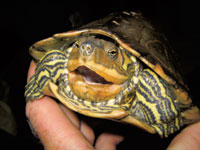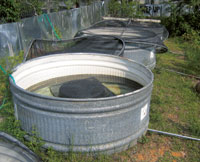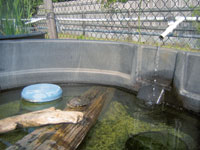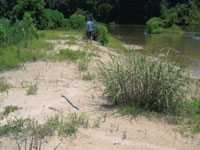The genus Graptemys, which includes all the map turtles, is endemic to the United States and Canada.
My first field experience with map turtles came in the summer of 1985, when I was helping to conduct a biological inventory of the Clinch River in southwestern Virginia. A small group of us were systematically turning large flat rocks in thigh-deep, clear, flowing water, hoping to see a mottled brown shape among brown and yellow cobble that would reveal a hellbender’s hiding place.
I turned a rock and peered into the water when a small, round, greenish shape caught my attention. A juvenile common map turtle was hiding under that rock. I think it was as surprised as I was to have found this unexpected little gem. I captured the turtle by hand and spent the next half hour photographing it before returning it to the Clinch.
 The heavy crushing beak of this Gibbon’s map turtle (G. gibbonsi) is designed for consuming snails and freshwater mussels. |
The genus Graptemys, which includes all the map turtles, is endemic to the United States and Canada. Map turtles are primarily species of riverine systems and rarely travel overland. Unusual for turtles in general, many of the map turtle species are restricted to one or perhaps two river systems. This is particularly true in the southeastern United States, where it seems that each major river system draining into the Gulf of Mexico from the Chattahoochee (Alabama/Georgia) west to the San Antonio (southeast Texas) contains a different map turtle. The high diversity of map turtles found in the southeastern United States is in large part responsible for the region being recognized as one of two global areas of greatest turtle diversity (the greatest area of turtle diversity is the Ganges-Brahmaputra River basin of eastern India and Bangladesh).
Of course, several map turtle species have very large ranges. The common map turtle (Graptemys geographica) ranges from Alabama north to Quebec. In the northern portion of its range it occurs in large, clear, glacial lakes, as well as the usual riverine haunts. Common maps are the only member of the group that occurs in rivers that drain to the Atlantic Ocean, notably the Susquehanna, Delaware and St. Lawrence.
By comparison, the false map turtle (G. pseudogeographica) is found throughout the upper Mississippi and Missouri River drainages.
Although all map turtles have dorsal keeling to various degrees, the narrow-headed group also contains those species with the most pronounced dorsal keels or knobs; these turtles are often referred to as “sawbacks.” The unique shell shape makes it possible to distinguish silhouettes of basking cooters (Pseudemys sp.) from maps from greater distances, which is quite helpful to field researchers.
Map turtles are alluring for turtle hobbyists because of their diversity and attractiveness. They are interesting to biologists and scientists who study the distribution and evolution of species on the landscape. Map turtles are also susceptible to riverine conditions, thus they have emerged as high priorities for conservationists in recent years.
 Juvenile map turtles of various species have been maintained successfully at the Savannah River Ecology Laboratory in stock tanks with flow-through systems, basking structures, platforms to hide beneath and screen covers to protect from raccoons and crows. |
Meet the Maps
There is continued discussion about the total number of map turtle taxa. As additional morphological and genetic studies are conducted, the taxonomic status may become clear. Currently, 13 full species are recognized.
Barbour’s map turtle (Graptemys barbouri). Barbour’s maps occur in the Chattahoochee, Flint and Apalachicola River system of Georgia, Alabama and Florida. Females have a very large head and body size (up to 121/2 inches) and are much larger than males (4 inches).
Alabama map turtle (G. pulchra). Alabama map turtles occur in the Alabama, Tombigbee, Coosa and Black Warrior River systems. Females are larger (111/2 inches) than males (5 inches), and the species has a noticeably pointed snout.
Escambia map turtle (G. ernsti). The Escambia map turtle occurs in the Escambia and Yellow rivers of the Florida Panhandle and adjacent Alabama. It is similar to, but recognized as distinct from, the Alabama map turtle.
Gibbon’s/Pascagoula map turtle (G. gibbonsi). Gibbon’s map turtles occur in the Pascagoula and Pearl River systems. It is similar to, but recognized as distinct from, the Alabama map turtle.
Common map turtle (G. geographica). The common map is probably the species that gave the group its name of “map” turtle. It has the largest range and is found in rivers and lakes as far north as Quebec and as far south as Alabama. Females are larger (111/2 inches) than males (61/2 inches). Although the heads of females are relatively large, neither head or sexual body size dimorphism is as extreme as the previous four species listed.
False map turtle (G. pseudogeographica). False maps inhabit the central Mississippi River drainage. Further taxonomic work is needed to determine its taxonomic status and relationship to other map turtles with which it intergrades. The Mississippi map turtle (G. pseudogeographica kohnii) is included under the false map turtle in this article; the iris of the eye is usually white. Females (101/2 inches) are larger than males (6 inches). False map turtles are distinguished from G. ouachitensis (described later) by the post-orbital crescent that blocks neck lines from reaching the eye.
Cagle’s map turtle (G. caglei). Cagle’s map turtles are found in the San Antonio and Guadalupe rivers of southeastern Texas. Females are larger (8 inches) than males (5 inches). They pluck aquatic insects from sunken log snags.
Texas map turtle (G. versa). Texas maps are endemic to the Colorado River system of Central Texas (not the Colorado River of Grand Canyon fame). This species appears to be somewhat omnivorous, consuming some aquatic plants, as well as insects. The species is relatively small, although females are larger (81/2 inches) than males (41/2 inches).
Ouachita map turtle (G. ouachitensis). Ouachita map turtles are found predominately in the southern Mississippi drainage, although they are known from southern Ohio. Up to seven lines on the head reach the eye orbit, and a black stripe is often visible on the iris of the eye. Females are larger (91/2 inches) than males (51/2 inches). This map is somewhat omnivorous, feeding on plants and insects.
Sabine map turtle (G. sabinensis). Sabine map turtles were recently recognized as distinct from, although similar to, the Ouachita map turtle. Sabine maps occur in the Sabine River and tributaries in western Louisiana and eastern Texas. The small, narrow-headed males eat some algae and aquatic insects that they pick from submerged logs.
Black-knobbed map turtle (G. nigrinoda). Black-knobbed map turtles occur in central Alabama’s Tombigbee, Alabama, Black Warrior, Coosa and Cahaba River systems. This “sawback” has two recognized subspecies: G. n. nigrinoda occurs in the upper Tombigbee and Alabama Rivers, while G. n. delticola appears to be restricted to the lower Mobile Bay drainage. Females are slightly larger (81/2 inches) than males (5 inches).
 Map turtles do best in captivity if they are provided with filtration or flowing-water systems. Basking sites and hiding places, such as those pictured, are also necessary. |
Yellow-blotched map turtle (G. flavimaculata). Yellow-blotched map turtles are endemic to the Pascagoula River system and several northern tributaries, the Leaf and Chickasawhay in Mississippi. Females (7 inches) are larger than males (41/2 inches). A solid yellow blotch in the center of each carapace scute distinguishes it from the ringed map turtle (see following). This species is listed as federally threatened due to declining population and habitat conditions.
Ringed map turtle (G. oculifera). Ringed maps are endemic to the Pearl and Bogue Chitto rivers in Mississippi and Louisiana. Females (81/2 inches) are larger than males (41/2 inches). A red hollow ring in the center of each carapace scute distinguishes it from the yellow-blotched map turtle. The species is listed as federally threatened resulting from declining population and habitat conditions.
Map turtles can be split into big-headed and narrow-headed groups. Enormously wide heads with heavy, thick jaws and crushing surfaces are found in the females of Barbour’s, Alabama, Gibbon’s and Escambia map turtles. The females of these species specialize in large freshwater mussels, while the males eat smaller crustaceans and aquatic insects.
The narrow-headed species include the black-knobbed, ringed, yellow-blotched, Cagle’s, Texas and Sabine maps, and a mid-range group with regard to head size includes the common, false and Ouachita map turtles.
 Sandbars that are above the highest summer flood waters and that have sparse ground vegetation are favored by most female map turtles. Tracks of nesting females are evident in the foreground of this photo. |
Wild Diet
All map turtles are carnivorous throughout their lives. Freshwater mussels, snails and crayfish are consumed by most species, especially the big-headed species previously described.
Unfortunately, the chronic pollution and sedimentation of many of our rivers have caused long-term declines in freshwater mollusks. Regrettably, freshwater mussels are among the world’s most endangered taxa. Undoubtedly, the diversity of map turtles in the southeastern United States is at least in part a result of the diverse mollusk fauna originally found there.
Although non-native invasive species are a problem worldwide, the colonization of many U.S. rivers by the Asiatic clam (Corbicula fluminea) may have an unintended but timely benefit for map turtles.
Map turtle sexes have been well documented to consume different foods. While the large females often feed on snails and mussels on river bottoms, males have been observed picking aquatic insects, such as mayflies, stoneflies and caddisflies, from floating woody debris and basking snags.
Captive Maintenance Musts
Because map turtles are creatures of flowing-water systems, their captive care requirements can be more challenging than for pond and wetland-dwelling species, such as the red-eared slider and other popular turtles. I have kept several map turtle species, both juveniles and males, for short periods of time in indoor aquariums. The key to their health rests on several factors.
A large aquarium with filtration is the primary requirement. External canister filters have worked well for me. I kept two Graptemys geographica males and one juvenile female G. pseudogeographica in a 75-gallon tank with a Marineland Magnum 330 canister filter for several years with no problems.
The water can be deep, as all map turtles are adept swimmers. I personally find maps attractive additions to a home aquarium, as visitors and guests, especially those who are not turtle fanciers, often become fascinated with turtles that are actively swimming in a near-full aquarium, as opposed to those that remain quiet and hidden in terrariums or shallow-water tanks.
Map turtles require basking sites that allow them to dry completely. Depending on your taste and creativity, basking structures may be constructed from pieces of unusual driftwood, or simple plastic egg crate materials.
Lighting for indoor setups must include a full-spectrum light with UVB to facilitate the assimilation of vitamin D. Incandescent bulbs suspended over the basking site will provide light and warmth. Maintain basking substrate temperature at approximately 90 degrees Fahrenheit.
Captive juvenile and male map turtles will consume commercial turtle chow, such as Mazuri’s Freshwater Turtle Diet. As much as possible, keepers should strive to provide the foods that these turtles encounter in the wild. Commercial crayfish operations exist throughout the South, and maintaining a separate habitat where crayfish can thrive and reproduce is worth the time and effort if large numbers of map turtles are being maintained.
Establishing snail populations in large outdoor ponds is also feasible, but maintaining freshwater mussels is beyond the abilities of most individuals. (It should be noted, however, that the U.S. Fish and Wildlife Service and Virginia Tech are working to establish colonies of endangered freshwater mussels using fish hatchery runways.)
Supplemental calcium is an important component in the captive care of map turtles. Remember, many Graptemys species occur in rivers and streams of limestone and karst regions. These are hard-water areas because more minerals, including calcium carbonate, are dissolved in the water. Also, by no coincidence, the rivers that map turtles occur in are often known for their rich diversity of freshwater mollusks, as well as crayfish and aquatic insects.
Water pH is measured by the number of hydrogen ions dissolved within. For our purposes, a pH measurement of 7.0 is considered neutral, less than 7 is acidic, greater than 7 is alkaline (or basic). Maintaining a neutral to slightly alkaline pH may also benefit captive map turtles. Many of us who keep captive turtles live in the southeastern United States where water from well-drained sandy Coastal Plain regions can often be slightly acidic. So, check the pH of your water supply and periodically check the pH in your map turtle enclosures.
Map turtles do well in outdoor setups, provided that circulating water is also provided. Given that all of the species are found in riverine systems, it makes sense to provide some current and to keep the water clear. Wild map turtles rarely display algae growth on their shells (algae on shells can indicate turtles that dwell in quiet waters). If they do, it seems to coincide with their occurrence in man-made reservoirs.
I have observed Barbour’s map turtles from an un-impounded, clear-flowing, cobble-bottomed section of the Flint River in Georgia to be beautiful animals. Barbour’s maps from the upper end of a reservoir on the Chattahoochee River, however, were often covered in algae with mud residue. Also of note, no mature female Barbour’s maps were observed in the reservoir on the Chattahoochee; a correlation with the loss of freshwater mussels and their cobble and sand substrates seems logical.
Large rocks and spreading log snags provide favorite hiding places. Also note that standard two-hole concrete blocks used in home construction (aka cinderblocks) are dangerous in outdoor turtle setups. For the beginning turtle hobbyist, they may seem like ideal structures for providing cover or forming the underpinnings of basking sites. Don’t use them. Even if your turtles initially fit inside and use them as hiding places, remember that your turtles will grow. Eventually, a turtle could get stuck and drown.
Conservation Issues
Because map turtles are riverine, they are susceptible to human impacts to those systems. Water pollution, siltation, removal of log snags for navigation and construction of dams have all contributed to declines in some species. The loss of freshwater mussels for these same reasons affects the food resources of many map turtle species. Sandbars, which are critically important as nesting areas, have been impacted by invasive vegetation, fire ants and human recreational use.
As a result of these cumulative impacts, and given that several map turtle species are restricted to single river systems, two species have been listed as federally threatened. Recently (effective June 14, 2006), all map turtles were added to Appendix III of CITES; therefore, documentation is now necessary before these turtles can be exported internationally.
Turtle hobbyists may be able to contribute to the conservation of some of these species in the future. For example, in theory, federal protection should lead to restrictions on further environmental degradation of habitats and provide funding for restoration and research. In the specific cases of ringed and yellow-blotched map turtles, it seems that captive head-starting might be one of several tools that could be used to recover the wild populations of these turtles. Of course, the environmental problems that caused their decline in the first place must first be remediated. But there are groups that are involved in habitat restoration and regulatory enforcement that turtle hobbyists could join to help build a complete conservation program for various map turtles.
After all, it would be a shame if children could not wade out into a clear river and observe a beautiful map turtle sitting on the bottom.

